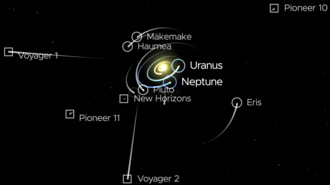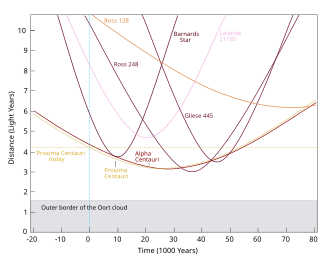

An interstellar probe is a space probe that has left—or is expected to leave—the Solar System and enter interstellar space, which is typically defined as the region beyond the heliopause. It also refers to probes capable of reaching other star systems.
As of 2024, there are five interstellar probes, all launched by the American space agency NASA: Voyager 1, Voyager 2, Pioneer 10, Pioneer 11 and New Horizons. Also as of 2024, Voyager 1 and Voyager 2 are the only probes to have actually reached interstellar space.[1] The other three are on interstellar trajectories. Contact to Pioneer 10 and 11 was lost long before they reached interstellar space.
The termination shock is the point in the heliosphere where the solar wind slows down to subsonic speed. Even though the termination shock happens as close as 80–100 AU (astronomical units) the maximum extent of the region in which the Sun's gravitational field is dominant (the Hill sphere) is thought to be at around 230,000 astronomical units (3.6 light-years).[2] This point is close to the nearest known star system, Alpha Centauri, located 4.36 light years away. Although the probes will be under the influence of the Sun for a long time, their velocities far exceed the Sun's escape velocity, so they are leaving forever.
Interstellar space is defined as the space beyond a magnetic region that extends about 122 AU from the Sun, as detected by Voyager 1, and the equivalent region of influence surrounding other stars. Voyager 1 entered interstellar space in 2012.[3]
Currently, three projects are under consideration: CNSA's Shensuo, NASA's Interstellar Probe, and StarChip from the Breakthrough Initiatives.
- ^ "Interstellar Mission". NASA Science. Retrieved May 25, 2024.
- ^ Chebotarev, G.A. (1964), "Gravitational Spheres of the Major Planets, Moon and Sun", Soviet Astronomy, 7 (5): 618–622, Bibcode:1964SvA.....7..618C
- ^ "NASA Voyager 1 Encounters New Region in Deep Space". NASA Jet Propulsion Laboratory (JPL).